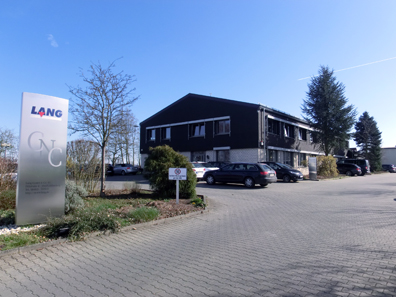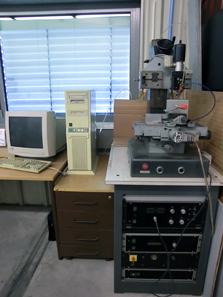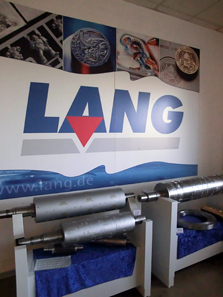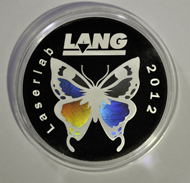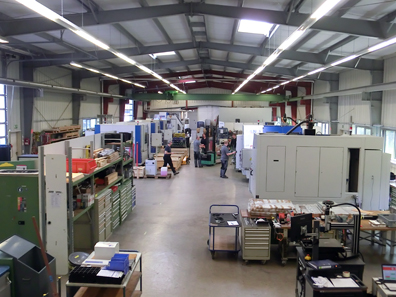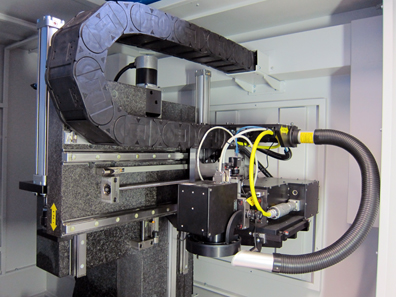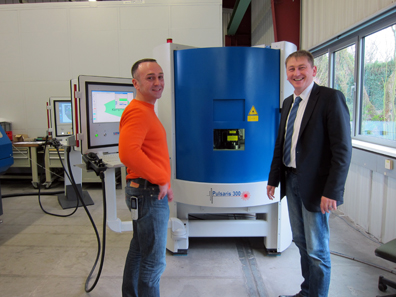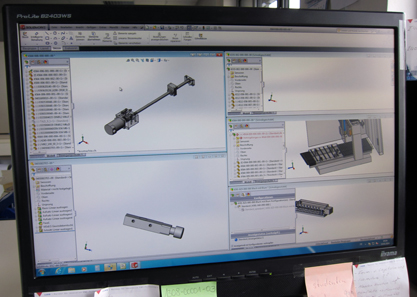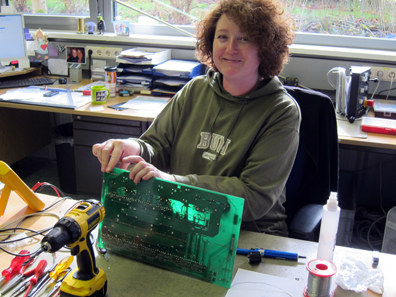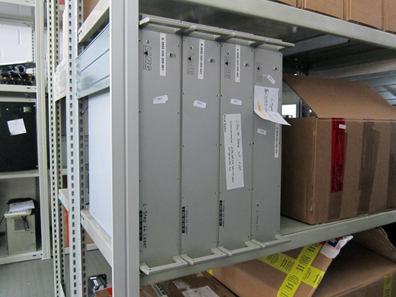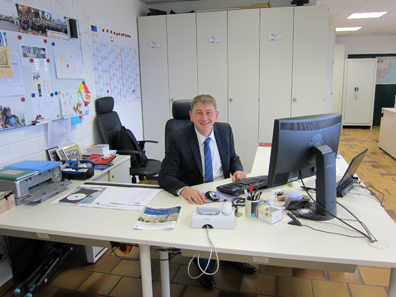by Ursula Kampmann
translated by Teresa Teklic
April 8, 2014 – Some 10,000 people live in the small municipality Hüttenberg, which lies between Wetzlar, Butzbach and Gießen. Hüttenberg is famous for its production of “Handkäse” (“handmade cheese”) more than for anything else. This sour milk cheese is a Hessian speciality, not very often served outside the state but enjoyed in Frankfurt as “Handkäse mit Musik” (literally: “handmade cheese with music”, another regional speciality) accompanied by “Ebbelwoi” (apple wine). Unlike this local delicacy, Lang GmbH & Co. KG has made a name for itself internationally. Among the list of Lang customers are mints from all over the world. Reason enough to make a trip to Hüttenberg.
Lang’s main building. Photo: Lang GmbH & Co. KG.
Lang GmbH & Co. KG was founded by DI Richard Lang in 1972 for the manufacture of automation systems. In the mid-1980s, some friends of his, who were engravers themselves, wondered if it wasn’t possible to automatise the process of engraving and milling those inscriptions which always remain the same by the use of automation machines.
One of the first computer-controlled engraving machines, developed for the company Leitz – and by the way, it still works today! Photo: Lang GmbH & Co. KG.
This resulted in the development of a software for three-dimensional engravings and the accompanying engraving machine, which can for instance be used to engrave camera lens adapter rings permanently.
What led to the company’s success was the high precision in transferring the engraving’s design onto the components. And there was one industry which needed exactly this technology in the mid-80s: the minting industry. In those years, after the silver boom, mints started to release commemorative coin programmes in an unprecedented scope. Therefore, the industry had to produce many more coining dies with fast changing motives than ever before in its history. Of course mints were on the look-out for cost-efficient means of producing a large number of dies directly from the model without many complicated intermediate steps. Automatized milling and engraving offered a speedy and cost-efficient alternative to traditional hubbing.
Previously, the master die had to be made from the original model in a long and complicated procedure by multi-stage hubbing, only to manufacture the actual negative minting dies in a second multi-stage hubbing procedure. Now, modern milling machines can reproduce as many dies as necessary from a three-dimensional original as necessary. This is the only way to mint a larger number of commemorative coin series cost-efficiently.
So it doesn’t come as a surprise that most of the major mints today use a Lang milling machine. Among the customers are the Austrian Mint, Goznak, the Monnaie de Paris, the Royal Canadian Mint as well as the mints of China, Kazakhstan, Poland and Singapore – just to name a few.
CoinsWeekly was very happy about the warm welcome. Photo: UK.
Today, Lang GmbH & Co. KG employs 75 people in their factory in Hüttenberg, under the direction of CEO and owner Volker Kozian. Another 25 employees work in Bad Lauterberg, where the affiliated firm Kuhlmann manufactures its milling machines. All production steps are vertically integrated: from programmers, who are responsible for the constant advancement of the programmes, engineers and machine builders, who design and build milling machines and scanners according to customer demands, to training and customer service. Lang prides itself on providing all-in-one solutions modifying the standard models until they fit the customer’s specific demands – and not just for customers from the minting industry.
The moulds in this exhibition room were produced with Lang machines. Photo: Lang GmbH & Co. KG.
One of Lang’s most important target groups is the packaging industry, but Lang machines are also used in biomedical engineering, the jewellery industry as well as by enterprises specialized in the tool and mold industry.
An example of what moulds used for the manufacturing of car tire sidewalls can look like. Photo: Lang GmbH & Co. KG.
Biggest client is the automobile industry. Lang is market leader in manufacturing the machines for the production of the moulds for car tire sidewalls and profiles. No matter what kind of car you drive, it is almost certain that your car tires were made with moulds from a Lang machine.
One of Lang’s new developments: the rainbow-effect on coins. Photo: Lang GmbH & Co. KG.
As mentioned before, the coin industry has been part of Lang’s range of services since the 1980s. Machines that are sold in this sector account for roughly 10 per cent of the total turnover. An important selling point for Lang is the fact that they provide all services themselves, from the digitalisation of the model, respectively from the CAD (computer-aided-design) / CAM (computer-aided-manufacturing) software which is used for designing motif and inscription on the computer up to the machine which turns all this information input into a coin die without intermediary steps.
So, for the development of custom-built models specialists from all areas get together at one table, which speeds up the development process enormously.
Lang’s production hall. Photo: UK.
The machines are built in this large production hall according to customer specifications. The CNC (Computerized Numerical Control) milling machine from the Impala series, for instance, is manufactured in this hall, but also all the other custom-built milling machines for the minting industry, not to forget Pulsaris, a laser machine which achieves fine structures not possible with traditional engraving systems, which made new developments possible like the rainbow effect.
By the way, for all those of you who were wondering – just like I was – what the advantage of mechanical milling is compared to modern laser technology: the mechanical process of traditional milling machines can ablate more layers of metal at once from planchets, so that a deep relief emerges relatively quickly. A laser, on the other hand, heats up the material by directing a laser beam at it until it vaporizes. Laser technology can accordingly be used to engrave much finer structures. A combination of the two processing methods is also possible. In this case, the majority of the material will be ablated by milling technology. Subsequently, laser technology produces structures on the relief which are so fine that they are not visible to the naked eye. This option is especially popular with customers from the security industry. Combining the two processing methods also reduces production costs because the advantage of milling machines lies in their ability to ablate larger amounts of the material, which, in turn, reduces the production time.
A solid granite basis guarantees stability and the highest possible precision. Photo: UK.
The highest possible precision is guaranteed by each Lang machine thanks to a solid basis made of granite. This rock was formed from magma more than 2 km deep below the earth’s surface and is much better suited for an optimal absorption of vibration and temperature fluctuation than steel or polymer concrete.
Joachim Steidel demonstrates the production capacity of the Pulsaris 300. To the left: Mr Bauer, application engineer. Photo: UK.
Applied, this means precision on a micrometre scale.
Several newly developed special parts of a Lang machine. Photo: UK.
This is where the electronic parts, hidden inside the machines, are made. Photo: UK.
Mr Serafin, director of the programming department. Photo: UK.
The software, too, is made by (and at) Lang – on the 1st floor of the main building.
The magazine, where spare parts are being prepared for shipping to customers. Photo: UK.
That is one of the reasons why Lang is able to provide such a comprehensive customer service. After all, all specialized contact persons work under one roof. Operating staff working with Lang machines, therefore, receives a very thorough training in all areas. If additional help is required, the problem can be solved online in 85 per cent of all cases. In the other 15 per cent, a Lang employee usually pays a visit to inspect the machine himself, or – and this happens much more frequently – Lang sends a spare part so that production can continue while the specialists in Hüttenberg take care of the faulty part in the meantime. The spare part delivery system, Joachim Steidel proudly tells us, runs so effectively that the spare parts can usually be delivered over-night, only shipping to Asia takes two days. Often, getting the spare part from the inbox to the waiting staff at the machine takes longer than the shipping from Hüttenberg to another continent.
Joachim Steidel’s office. Photo: UK.
You could almost say that the biggest problem of Joachim Steidel, sales manager at Lang, is this: the machines he sells are simply too long-living and customers almost never need any spare parts. Most machines have been running for 20 years without any problems.
Still, in order to keep pace with the newest technological developments, Lang has developed a programme for its customers which enables them to update any machine – no matter what the year of manufacture – to the newest technological standard.
But Lang is not only well connected internationally, the firm also has excellent local connections in Hüttenberg. The handball team TV 05/07 Hüttenberg, that is well-known in the region and beyond and was repeatedly awarded for its outstanding youth work, proudly thanks Lang as its main sponsor in its website.
Find out more about Lang on the company’s website.
You can find all machines in the product overview.
Click here if you are interested in different applications of Lang machines.
Read about the services Lang provides here.
You can access the Kuhlmann website via this link.
Here you can watch a report on a victory of the TV Hüttenberg.
And if you have half an hour of time, you can watch how to prepare the typical speciality “Handkäs with music”.




